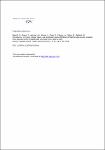Prevalence, serovars, phage types, and antibiotic susceptibilities of Salmonella strains isolated from animals in the United Arab Emirates from 1996 to 2009
Münch, Sebastian
Braun, Peggy
Wernery, Ulrich
Kinne, Jörg
Pees, Michael
Flieger, Antje
Tietze, Erhard
Rabsch, Wolfgang
The aim of this study was to give some insights into the prevalence, serovars, phage types, and antibiotic resistances of Salmonella from animal origin in the United Arab Emirates. Data on diagnostic samples from animals (n = 20,871) examined for Salmonella between 1996 and 2009 were extracted from the databases of the Central Veterinary Research Laboratory in Dubai and from typed strains (n = 1052) from the Robert Koch Institute, Wernigerode Branch in Germany and analyzed for general and animal-specific trends. Salmonella was isolated from 1,928 (9 %) of the 20,871 samples examined. Among the 1,052 typed strains, most were from camels (n = 232), falcons (n = 166), bustards (n = 101), antelopes (n = 66), and horses (n = 63). The predominant serovars were Salmonella Typhimurium (25 %), Salmonella Kentucky (8 %), followed by Salmonella Frintrop (7 %), and Salmonella Hindmarsh (5 %). When analyzed by animal species, the most frequent serovars in camels were Salmonella Frintrop (28 %) and Salmonella Hindmarsh (21 %), in falcons Salmonella Typhimurium (32 %), in bustards Salmonella Kentucky (19 %), in antelopes Salmonella Typhimurium (9 %), and in horses Salmonella Typhimurium (17 %) and S. Kentucky (16 %). Resistance of all typed Salmonella strains (n = 1052) was most often seen to tetracycline (23 %), streptomycin (22 %), nalidixic acid (18 %), and ampicillin (15 %). These data show trends in the epidemiology of Salmonella in different animal species which can be used as a base for future prevention, control, and therapy strategies.
Dateien zu dieser Publikation
Keine Lizenzangabe

